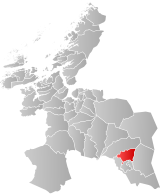Glåmos is a former municipality in the old Sør-Trøndelag county in Norway. The short-lived municipality existed from 1926 until its dissolution in 1964. It was located in the northern part of what is now the municipality of Røros in Trøndelag county.
Glåmos Municipality
Glåmos herred | |
|---|---|
 View of Glåmos | |
 Sør-Trøndelag within Norway | |
 Glåmos within Sør-Trøndelag | |
| Coordinates: 62.6714°N 11.4288°E | |
| Country | Norway |
| County | Sør-Trøndelag |
| District | Gauldalen |
| Established | 1926 |
| • Preceded by | Røros Municipality |
| Disestablished | 1 Jan 1964 |
| • Succeeded by | Røros Municipality |
| Administrative centre | Glåmos |
| Population (1964) | |
• Total | 700 |
| Demonym | Glåmosing[1] |
| Official language | |
| • Norwegian form | Neutral |
| Time zone | UTC+01:00 (CET) |
| • Summer (DST) | UTC+02:00 (CEST) |
| ISO 3166 code | NO-1643[3] |
It included all the area around the headwaters of the river Glåma and the areas surrounding the northern and western sides of the lake Aursunden. The administrative centre was the village of Glåmos where Glåmos Church is located.[4]
The municipality had some old copper mines located in the mountains near the village that used to supply the Røros Copper Works in the nearby town of Røros.
History


The parish of Glåmos was established as a municipality in 1926 when the large municipality of Røros was split into four separate municipalities: Glåmos (population: 983), Brekken (population: 1,098), Røros landsogn (population: 701), and the town of Røros (population: 2,284).[5]
During the 1960s, there were many municipal mergers across Norway due to the work of the Schei Committee. On 1 January 1964, the four municipalities of Glåmos (population: 700), Brekken (population: 964), Røros landsogn (population: 482), and the town of Røros (population: 3,063) were all reunited under the name Røros.[5]
Name
The municipal name is a relatively new construction. It was chosen to represent the area around the river Glåma, near the mouth of the lake Aursunden. The first element is based on the name of the river Glåma (Old Norse: glaumr or raumr) which may mean "loud noise" or "thunder". The last element comes from the Old Norse word óss which means "river mouth".[4]
Government
While it existed, this municipality was responsible for primary education (through 10th grade), outpatient health services, senior citizen services, unemployment, social services, zoning, economic development, and municipal roads. During its existence, this municipality was governed by a municipal council of elected representatives, which in turn elected a mayor.[6]
Mayors
Municipal council
The municipal council (Herredsstyre) of Glåmos was made up of 13 representatives that were elected to four year terms. The party breakdown of the final municipal council was as follows:
| Party name (in Norwegian) | Number of representatives | |
|---|---|---|
| Labour Party (Arbeiderpartiet) | 11 | |
| Local List(s) (Lokale lister) | 2 | |
| Total number of members: | 13 | |
| Party name (in Norwegian) | Number of representatives | |
|---|---|---|
| Labour Party (Arbeiderpartiet) | 9 | |
| List of workers, fishermen, and small farmholders (Arbeidere, fiskere, småbrukere liste) | 4 | |
| Total number of members: | 13 | |
| Party name (in Norwegian) | Number of representatives | |
|---|---|---|
| Labour Party (Arbeiderpartiet) | 10 | |
| Local List(s) (Lokale lister) | 2 | |
| Total number of members: | 12 | |
| Party name (in Norwegian) | Number of representatives | |
|---|---|---|
| Labour Party (Arbeiderpartiet) | 10 | |
| Local List(s) (Lokale lister) | 2 | |
| Total number of members: | 12 | |
| Party name (in Norwegian) | Number of representatives | |
|---|---|---|
| Labour Party (Arbeiderpartiet) | 10 | |
| Local List(s) (Lokale lister) | 2 | |
| Total number of members: | 12 | |
| Party name (in Norwegian) | Number of representatives | |
|---|---|---|
| Labour Party (Arbeiderpartiet) | 9 | |
| Joint List(s) of Non-Socialist Parties (Borgerlige Felleslister) | 3 | |
| Total number of members: | 12 | |
| Note: Due to the German occupation of Norway during World War II, no elections were held for new municipal councils until after the war ended in 1945. | ||
See also
References
Wikiwand in your browser!
Seamless Wikipedia browsing. On steroids.
Every time you click a link to Wikipedia, Wiktionary or Wikiquote in your browser's search results, it will show the modern Wikiwand interface.
Wikiwand extension is a five stars, simple, with minimum permission required to keep your browsing private, safe and transparent.